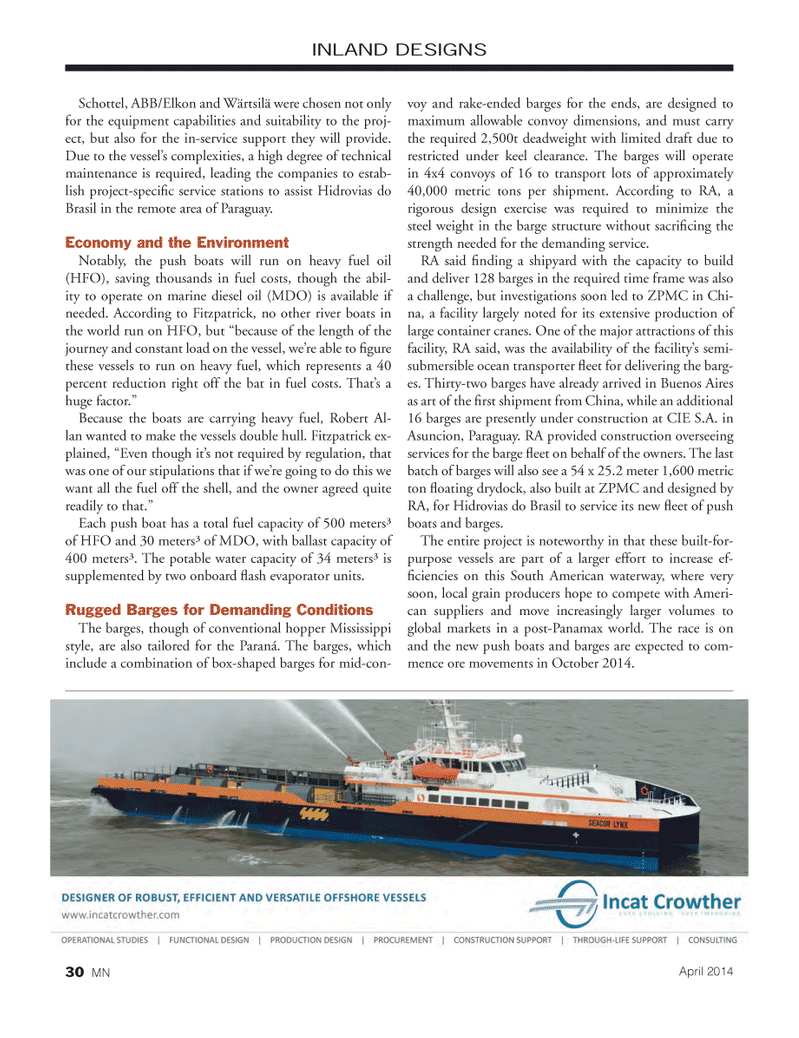
Page 30: of Marine News Magazine (April 2014)
Shipyard Report: Construction & Repair
Read this page in Pdf, Flash or Html5 edition of April 2014 Marine News Magazine
INLAND DESIGNSSchottel, ABB/Elkon and Wärtsilä were chosen not only for the equipment capabilities and suitability to the proj- ect, but also for the in-service support they will provide. Due to the vessel?s complexities, a high degree of technical maintenance is required, leading the companies to estab- lish project-speci c service stations to assist Hidrovias do Brasil in the remote area of Paraguay. Economy and the Environment Notably, the push boats will run on heavy fuel oil (HFO), saving thousands in fuel costs, though the abil-ity to operate on marine diesel oil (MDO) is available if needed. According to Fitzpatrick, no other river boats in the world run on HFO, but ?because of the length of the journey and constant load on the vessel, we?re able to gure these vessels to run on heavy fuel, which represents a 40 percent reduction right off the bat in fuel costs. That?s a huge factor.? Because the boats are carrying heavy fuel, Robert Al- lan wanted to make the vessels double hull. Fitzpatrick ex- plained, ?Even though it?s not required by regulation, that was one of our stipulations that if we?re going to do this we want all the fuel off the shell, and the owner agreed quite readily to that.? Each push boat has a total fuel capacity of 500 meters³ of HFO and 30 meters³ of MDO, with ballast capacity of 400 meters³. The potable water capacity of 34 meters³ is supplemented by two onboard ash evaporator units. Rugged Barges for Demanding Conditions The barges, though of conventional hopper Mississippi style, are also tailored for the Paraná. The barges, which include a combination of box-shaped barges for mid-con- voy and rake-ended barges for the ends, are designed to maximum allowable convoy dimensions, and must carry the required 2,500t deadweight with limited draft due to restricted under keel clearance. The barges will operate in 4x4 convoys of 16 to transport lots of approximately 40,000 metric tons per shipment. According to RA, a rigorous design exercise was required to minimize the steel weight in the barge structure without sacri cing the strength needed for the demanding service. RA said nding a shipyard with the capacity to build and deliver 128 barges in the required time frame was also a challenge, but investigations soon led to ZPMC in Chi- na, a facility largely noted for its extensive production of large container cranes. One of the major attractions of this facility, RA said, was the availability of the facility?s semi- submersible ocean transporter eet for delivering the barg- es. Thirty-two barges have already arrived in Buenos Aires as art of the rst shipment from China, while an additional 16 barges are presently under construction at CIE S.A. in Asuncion, Paraguay. RA provided construction overseeing services for the barge eet on behalf of the owners. The last batch of barges will also see a 54 x 25.2 meter 1,600 metric ton oating drydock, also built at ZPMC and designed by RA, for Hidrovias do Brasil to service its new eet of push boats and barges.The entire project is noteworthy in that these built-for- purpose vessels are part of a larger effort to increase ef- ciencies on this South American waterway, where very soon, local grain producers hope to compete with Ameri- can suppliers and move increasingly larger volumes to global markets in a post-Panamax world. The race is on and the new push boats and barges are expected to com- mence ore movements in October 2014. April 201430 MNMN April14 Layout 18-31.indd 30MN April14 Layout 18-31.indd 303/20/2014 11:50:28 AM3/20/2014 11:50:28 AM

 29
29

 31
31
